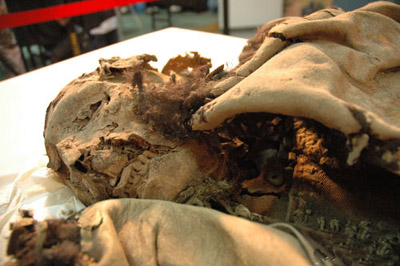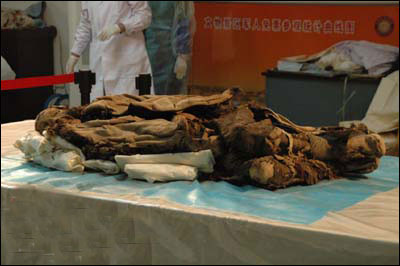| Tools: Save | Print | E-mail | Most Read |
| Lab Work to Identify 2,800-year-old Mummy of Shaman |
| Adjust font size: |
The well-preserved mummy of a seemingly Caucasian man with a Roman nose and deep-set eyes was unearthed from a cluster of ancient tombs in 2003 and research work has been going on ever since. Archeologists found the mummy most intriguing because a sack of marijuana leaves was found buried alongside the corpse. The mummy remains intact in its original outfit despite the passage of time: leather hat, heavy coat and boots, huge earrings of copper and gold, a turquoise necklace, a copper laced stick in the right hand and a bronze ax in the left, according to Li Xiao, head of the heritage bureau in Turpan. Inside the leather coat, the man was wearing a dainty brown and red mantle, and his hands were crossed in front of his chest, said Li. "From his outfit and the marijuana leaves, which have been confirmed by international specialists to be ingredients for narcotic, we assume the man had been a shaman and had been between 40 and 50 years old when he died," said Li, a noted historian in Xinjiang. He said the corpse is about 1.2 meters long and its legs are at least 80 centimeters. Li and his colleagues are taking fabrics from the mummy's clothes for laboratory work, hoping to identify the mummy and unravel more mysteries of shaman clothing, culture and religion. The mummy was the best preserved one among some 600 excavated in 2003 from a cluster of 2,000 tombs in Turpan. Archeologists assume the tombs, which dated from the Bronze Age to the Tang Dynasty (618 - 907), belonged to several big clans. The tombs also produced a wide variety of stone implements, bronzeware, color chinaware pieces and knitwear.
(Xinhua News Agency December 23, 2006) |
| Tools: Save | Print | E-mail | Most Read |
 |
| Related Stories |


